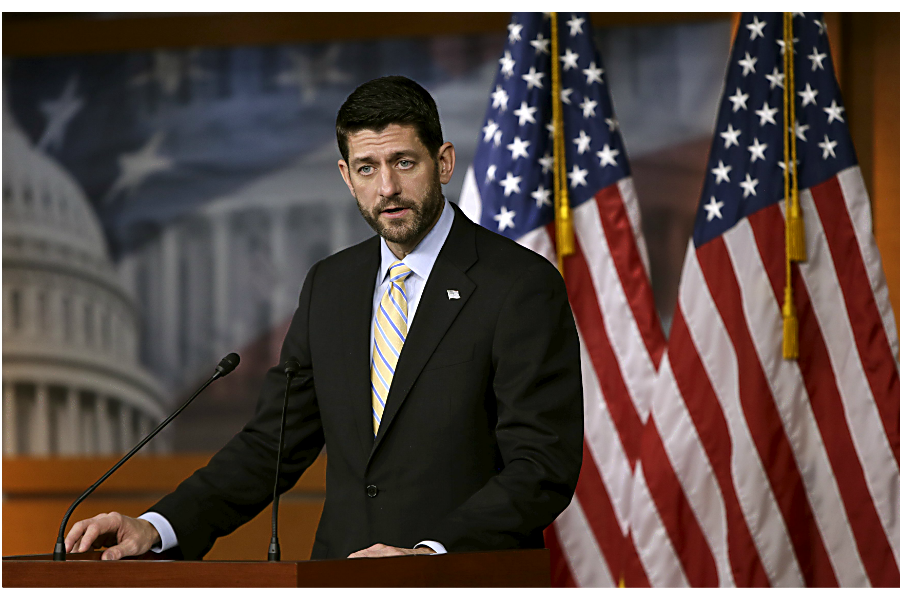Paul Ryan sets out task: turn GOP into party of positive ideas
Loading...
| Washington
House Speaker Paul Ryan has one big goal for 2016 – coming up with a bold, positive Republican agenda so that “Mr. and Mrs. America,” as he puts it, have a clear choice in the upcoming elections.
Republicans, deeply divided and shouldering a wide field of presidential candidates, could certainly use an affirming vision that unites and inspires them. As the party’s acknowledged “ideas man” and a former vice presidential candidate, the energetic speaker from Wisconsin is in a good position to outline that agenda, observers say.
“With more than a dozen candidates for president going in different directions, the burden falls on Ryan to try to define a positive national message,” says former House historian Raymond Smock in an e-mail. “Big assignment.”
The speaker got started on this project last week, outlining his vision in a speech at the Library of Congress. It had its own Twitter hashtag, #ConfidentAmerica.
Sounding much like a presidential candidate, he laid down several markers: a greatly simplified tax code, a replacement for “Obamacare,” welfare reform 2.0, and a strong America as the leader on the world stage.
But his words got drowned out by events – the mass shooting in San Bernardino, Calif., and by the campaign rhetoric that followed – particularly Donald Trump’s call to temporarily ban all Muslims from entering the United States.
And therein lies just one of the challenges that Speaker Ryan will have as he turns to his Republican colleagues to flesh out an agenda in January, when House members gather at their annual retreat.
“Breaking through the noise is definitely a problem,” says GOP strategist Matt Mackowiak. “The presidential campaign dominates. It’s hard for even candidates for governor and the US Senate to break through, and so it will be hard for him as well.”
Ryan's clout
Another potential problem is the raucous caucus itself. Can he unite members behind a vision?
Despite its many attempts to repeal the Affordable Care Act, the GOP-controlled House was never able to agree on a replacement for it. Tax reform, too, is a really tough one – though it’s Ryan’s specialty.
Many say that if anyone can unite Republicans behind a vision, it’s the new conservative speaker. He has strong backing from all corners of his caucus, but is facing a test as he tries to carry a giant spending bill over the finish line by Dec. 16.
If he succeeds in his vision effort, it could significantly affect the Republican Party, says John Pitney, a congressional expert at Claremont McKenna College in Claremont, Calif.
“He has strong potential to drive the debate and get material out there that could become part of the Republican conversation. And if there’s a Republican president in 2016, Ryan’s ideas will become very consequential because that president may well adopt them,” Professor Pitney says.
It’s happened before.
How other leaders have succeeded
Ronald Reagan’s signature “supply side” tax cuts started on the Hill, with then-Rep. Jack Kemp (R) of New York as a key player, Pitney says. Similarly, a prescription drug benefit and education reform were simmering in Congress before George W. Bush took office.
And former Speaker Newt Gingrich’s “Contract With America” helped lead to a Republican sweep of Congress in the midterm elections of 1994 – the so-called Republican revolution.
The contract came out six weeks before the election. Ryan wants his agenda out there much earlier than that. He told reporters on Thursday that his experience on a presidential ticket – he was Mitt Romney’s running mate in 2012 – tells him voters need to hear the message early and often.
If he can produce it by February or March, he can perhaps begin to shape what the GOP platform will look like and what a presidential nominee might run on, Mr. Mackowiak says. All the better if it’s a positive message, since Republicans in the Obama era have become known as the “party of ‘no.’ ”
Mackowiak sees another advantage. If Mr. Trump becomes the nominee, candidates up and down the ballot would have an agenda to run on, given Trump’s tendency to go against the grain. “In a way, this is a hedge against Trump,” says Mackowiak, though he doubts Ryan is thinking of it that way.
What will voters think?
Even if Ryan can unite his party behind a vision and that vision can be seen in the dust storm of a presidential election year, the question remains: Will voters like it?
Democrats are sure to pounce, just as they did in 2012 with Ryan’s plan to turn Medicare into a partial voucher system. The “granny” ad, which depicted a Ryan look-alike pushing an elderly woman in a wheelchair over a cliff, was politically devastating for Republicans.
Still, Ryan could be just what Republicans need right now.
He’s young and energetic. He’s looked at politics from his office as a legislator and from the stage of a presidential nominating convention. So far, he’s managed to tame the hard-right Freedom Caucus by including them in the decisionmaking process. And he’s rapidly becoming “Mr. Sunday” on the TV talk shows.
Mr. Smock, the historian, ventures that Ryan is trying to tilt the balance of power in Washington back to Congress.
“I can’t think of anyone other than Newt, who planned to use the speakership to rival the presidency and shift agenda-setting from the White House to the House of Representatives,” he writes.
A big assignment, indeed.






